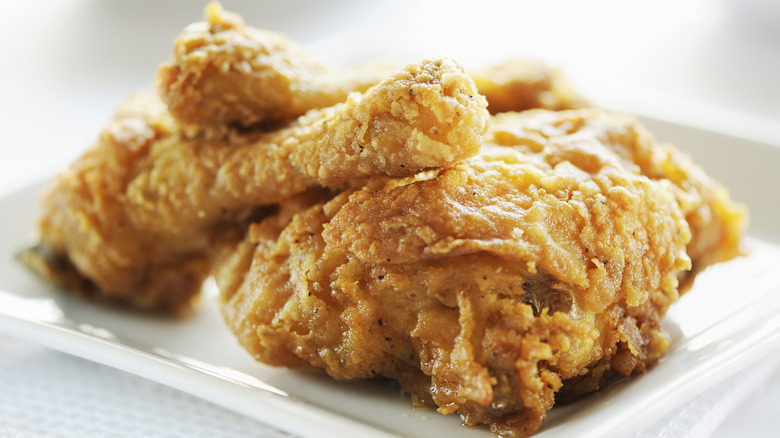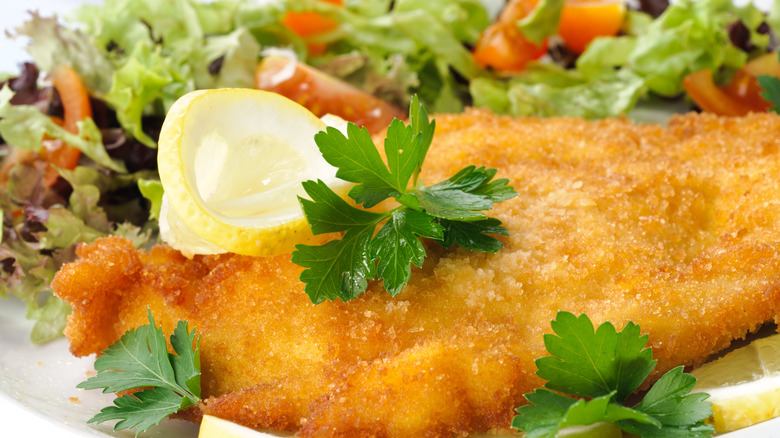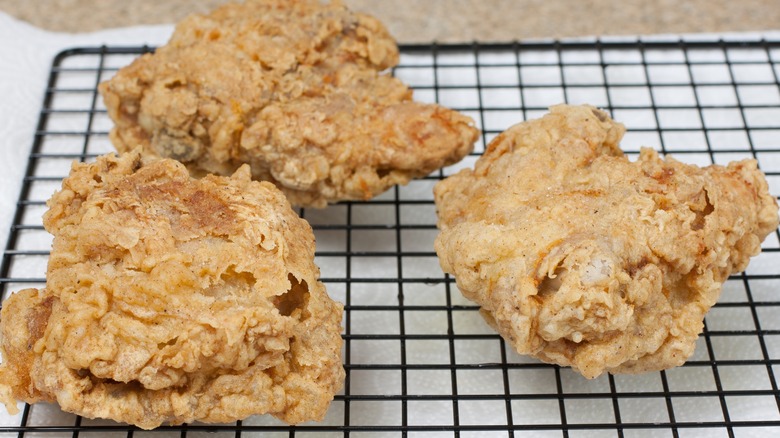Your Breaded Chicken Is Soggy Because Of One Simple Mistake
Fried chicken comes in so many glorious forms: fingers, nuggets, Milanese, schnitzel, and Southern fried, just to name a few. Many also embrace it when coated in breadcrumbs, crushed pretzels, cereal, Parmesan, or polenta-crusted form. Even drier white meat is succulent when breaded and fried in hot oil. But, whether treating the poultry to the traditional three-step breading process or just dredging it in seasoned flour, all your hard work is in vain if it turns out soggy.
Since the breading is the best part, it makes sense that home cooks would want to add as much coating as possible. But too much of a good thing may be the issue if your breaded chicken ends up soggy and one simple mistake may be what's preventing those drumsticks from golden brown crispiness: double dipping.
Whether the dredged chicken is going directly into the frying pan or first making a stop in an egg wash and breadcrumb coating, the chicken only needs a thin layer of flour. A thick flour coating will absorb too much oil and prevent the coating from crisping. To eliminate the issue, dredge raw chicken parts (boneless, skinless, or bone-in) in a bag with seasoned flour and shake until the pieces are coated. Remove excess flour before cooking. This layer will fry up crispy or, if you're using breadcrumbs, will prevent them from falling off.
Tips for cooking crispy breaded chicken
Once the chicken is coated, a few additional factors can influence whether your fried chicken will be crispy and juicy: the moisture level and temperature. Moisture is the enemy of anything that you want to brown. So, it's essential to dry raw chicken before dredging it in flour. If the surface is too wet, the breading won't stick and will burn in the frying pan. Leaving it uncovered in the refrigerator will help dry out the surface. Just store the chicken on the bottom shelf and avoid placing it next to raw vegetables to prevent cross-contamination.
The temperature of the oil and raw chicken is also critical. You'll want to use a neutral-tasting oil like canola, vegetable, or peanut oil with a high smoke point. Monitor the temperature with a thermometer, adjusting the heat as necessary. If the oil isn't kept at around 350 degrees Fahrenheit, the breading will absorb excess oil and become soggy.
Placing cold chicken in hot oil will lower the cooking temperature as well, so allow the chicken to sit for roughly 30 minutes at room temperature before dredging and frying so it doesn't lower the cooking temperature too drastically. You can also control it by not overcrowding the pan. Trying to cook too much at one time will make the oil cool. It's better to fry the chicken in batches, keeping the cooked chicken warm until you are ready to eat.
Now that it's cooked, what's next?
Once the chicken has reached an internal temperature of 165 degrees Fahrenheit and the exterior is golden brown, season it with kosher salt and allow it to drain. Although paper towels are commonly used to absorb the excess oil, placing the hot, cooked chicken on a paper towel will cause the crust to steam and turn soggy. Instead, let the chicken rest on a wire cooling rack set over a paper towel or baking sheet to collect the grease. The extra oil will drain while allowing air to circulate around the chicken, preventing it from steaming.
If you are frying in batches, place the cooked chicken on the rack directly into a 200-degree Fahrenheit oven to keep warm. As tempting as it is to dig right in, resist! Not only will the inside be lava hot, but all the juices will run out. Similar to grilling an expensive steak, allow the fried chicken to rest for 10 minutes before enjoying it, giving its juices time to redistribute. The crust will be closer to room temperature, but the inside will still be hot.



